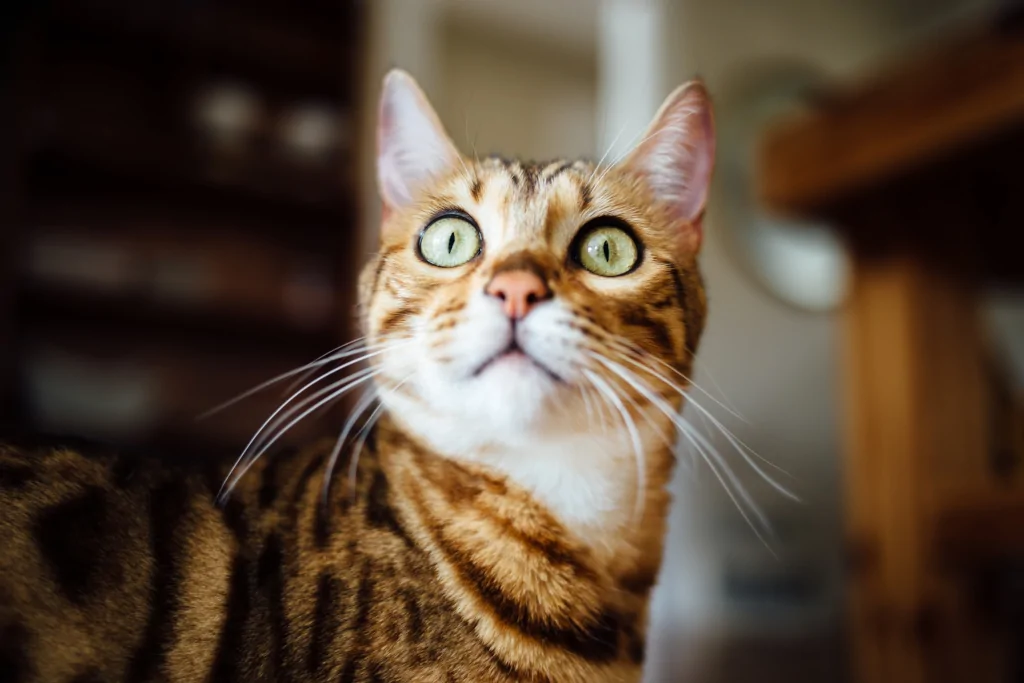Disclosure: We may earn a commission from helpful, relevant links in our content. No cost to you. See our privacy policy.
Has your feline friend ever woken you up with a slap to the face? It’s a perplexing behavior that leaves many cat owners wondering why their cat does this and how to discourage it.
In this article, we’ll explore the reasons behind face-slapping and how to gently teach your cat alternative ways to interact with you.

Why Does My Cat Swat Me in the Face?
Cats may swat their owners in the face for various reasons, such as seeking attention, initiating play, or expressing affection.
In some cases, face-slapping might be an attempt to wake you up for food or company.
Cats are perceptive creatures, and they quickly learn that a gentle tap on the face is an effective way to get their human’s attention.
Is Face-Slapping a Form of Communication or Play?
Face-slapping can be a form of communication, play, or even a sign of annoyance or aggression for your cat.
They may be trying to tell you they want something, like food or a cuddle, or they may simply be in a playful mood and looking for some interaction. In some cases, face-slapping could indicate that your cat is annoyed or doesn’t like something.
Observing your cat’s body language and the context of the situation will help you better understand their intentions behind this behavior.
Relaxed ears and a swishing tail usually indicate a playful mood, while more persistent swats or flattened ears and hissing may suggest your cat is trying to communicate a need, desire, or feeling of annoyance or aggression.
How Can I Gently Discourage This Behavior?
To gently discourage face-slapping behavior, it’s essential to address the underlying reasons for it.
When my cat Smokey used to slap me in the face, I noticed that he often did it when he was hungry or bored. To address his needs, I made sure to establish a consistent feeding schedule and provided him with plenty of interactive toys and playtime.
Additionally, I practiced redirecting his attention to a toy or treat whenever he tried to slap my face. Over time, this helped Smokey understand that there were better ways to communicate his needs or initiate play without resorting to face-slapping.
How To Redirect Your Cat’s Face-Slapping Behavior?
Offering positive alternatives to face-slapping is crucial in helping your cat learn more appropriate behaviors.
One option is to introduce interactive toys that encourage your cat to play independently, like puzzle feeders or toys with feathers and strings. For instance, I bought this treat-dispensing toy for Smokey, which he loves batting around, providing both mental stimulation and an outlet for his energy.
Another positive alternative is to schedule regular play sessions with your cat using toys like laser pointers or wand toys. I found that setting aside just 15 minutes twice a day for playtime with Smokey not only reduced his face-slapping behavior but also helped us bond and improve our overall communication.
By providing your cat with engaging activities and positive interactions, you’ll help them learn more appropriate ways to express themselves and connect with you.
Building Better Bonds With Your Cat
Building a strong bond with your cat can help address face-slapping behavior and improve your overall relationship. One effective way to strengthen your bond is through positive reinforcement.
For example, when my cat Smokey would approach me without slapping my face, I’d praise him and offer a treat as a reward. This helped reinforce the desired behavior, showing him that there were more effective ways to gain my attention.
Other bonding activities can include grooming, engaging in playtime, and simply spending quality time together, such as cuddling on the couch during a favorite TV show.
By understanding your cat’s unique needs and preferences, you’ll be able to foster a loving and lasting bond that encourages positive behavior.
FAQs
Is face-slapping a sign of aggression in cats?
Face-slapping can be a sign of aggression in cats, but it is often related to play, attention-seeking, or communication. Evaluate the context and your cat’s body language to determine the reason behind the behavior.
How can I tell if my cat is trying to get my attention or play?
Pay attention to your cat’s body language and vocalizations. If their ears are forward and they’re purring or meowing, they likely want attention or play. If their body appears tense or they’re hissing, they may be agitated or fearful.
Can I train my cat to use alternative forms of communication?
Yes, you can train your cat to use alternative forms of communication, such as touching a designated item or using vocalizations. Consistency, patience, and positive reinforcement are key to successful training.
Are certain breeds more prone to face-slapping?
Face-slapping behavior can be seen in any breed of cat. However, highly active and intelligent breeds may be more likely to engage in this behavior due to their need for stimulation and interaction.
Alex, a passionate animal lover, has experience in training and understanding animal behavior. As a proud pet parent to two dogs and three cats, he founded AnimalReport.net to share insights from animal experts and expand his knowledge of the animal kingdom.




